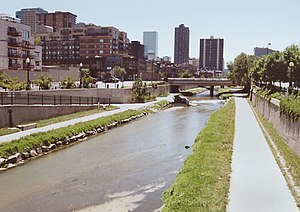 | Scott Friedman Broker Associate Prudential Colorado Real Estate
| Contact me at: |
| http://www.lighthouseteam.com | ||
Monday, March 12, 2007
Thursday, March 1, 2007
Cherry Creek, Colorado
 Cherry Creek is a tributary of the South Platte River, 64 mi (103 km) long, in Colorado in the United States.
Cherry Creek is a tributary of the South Platte River, 64 mi (103 km) long, in Colorado in the United States.It rises in the high plateau, east of the Front Range, in northwestern El Paso County. It flows north, through Castlewood Canyon State Park, past Parker and through portions of Centennial and Aurora, and into southeast Denver. It flows northwest through Denver, becoming an urban stream and joining the South Platte at Confluence Park in central Denver just west of downtown and approximately 5 mi (8 km) east of the foothills, near the site where the city of Denver was founded in 1858.
The 140 ft (43 m) high Cherry Creek Dam, completed 1950, forms Cherry Creek Reservoir in Cherry Creek State Park, providing flood control and irrigation. The dam lies immediately southeast and southwest of the Denver and Aurora city limits, respectively, approximately 8 mi (13 km) from the creek's confluence with the South Platte.
The creek lends its name to the Cherry Creek neighborhood in south-central Denver, and in particular to the Cherry Creek Shopping Center and to a prominent neighborhood newspaper, the Cherry Creek News.
The creek itself is locally well known for its population of crayfish. Some local inhabitants catch and eat these crustaceans, though this is of questionable legality. The creek is also home to a large population of small fish (Including immature trout and sunfish). Large fish are largely absent, except when the Cherry Creek Dam is partially opened and floodwaters carry fish such as rainbow trout, brown trout, mature sunfish, and even northern pike downstream. The creek's ecosystem was damaged during a drought in the first few years of the 21st century. Plants along the banks, damaged by the drought, dropped organic debris into the water, increasing biochemical oxygen demand substantially. Decreased flow also limited the ecosystem's capacity to supply needed oxygen. Decreased flow also prevented the washing away of pollutants such as NPK fertilizers, insecticides and organic solvents. Water temperatures also rose during this period, compounding the problem. As of 2005, however, the creek is substantially healthier.
For some of its distance, notably in the region of Four Mile Historical Park, the creek is flanked on each side by approximately 15 m (50 ft) of woods and scrub. This corridor is deliberately left semi-wild, though there is a dirt bike track on the northern bank. This corridor is one of the few places within the Denver metro area where the creek's namesake plant, the chokecherry, can still be seen in a largely wild state. Large trees such as cottonwoods are common, as are willows. Edible plants such as wild asparagus and prickly pear are occasionally found. Imported plants such as the Russian olive, dandelion, and Virginia creeper are also notably present. Despite the limited area this corridor offers, raccoons, beaver, foxes, and even deer are not uncommom sights along the creek. The beaver typically have lodges upstream (east) of Denver, but swim downstream to forage.
Petrified wood is extremely common in the creek. It is washed down, sometimes in fairly large pieces, from 'petrified forests' upstream. Fossil mammal bones have also been found.
Historical records kept at what is now Four Mile Historical Park indicate that prior to the construction of the Cherry Creek Dam, the creek's water level rose and fell regularly. Since the dam's completion, however, this flood cycle has been interrupted. Now, the flow is regulated almost exclusively by the dam's operators. The level of the creek is kept constant except when water needs to be vented from the Cherry Creek Reservoir. When the dam's floodgates are opened for this venting, the creek's level may rise as much as two feet, sometimes in less than an hour.
This article is licensed under the GNU Free Documentation License.
It uses material from the Wikipedia article Cherry Creek, Colorado.
It uses material from the Wikipedia article Cherry Creek, Colorado.
Subscribe to:
Posts (Atom)